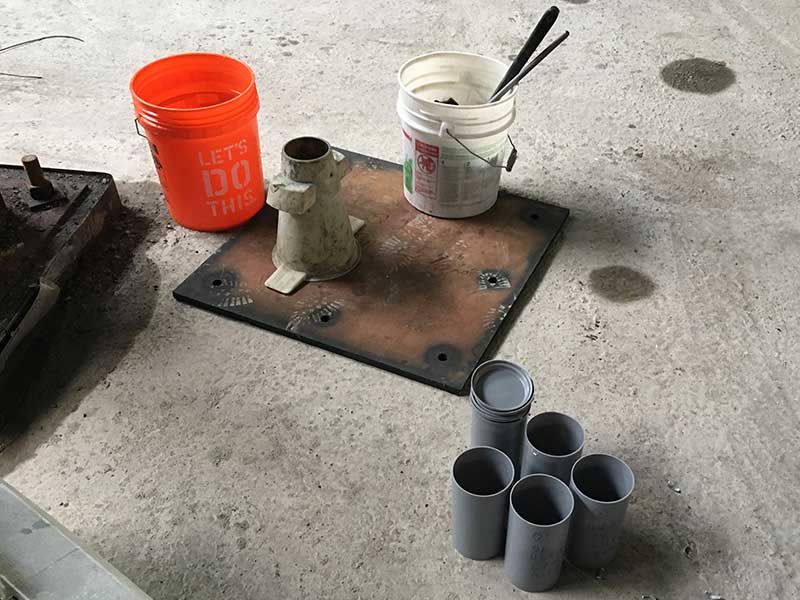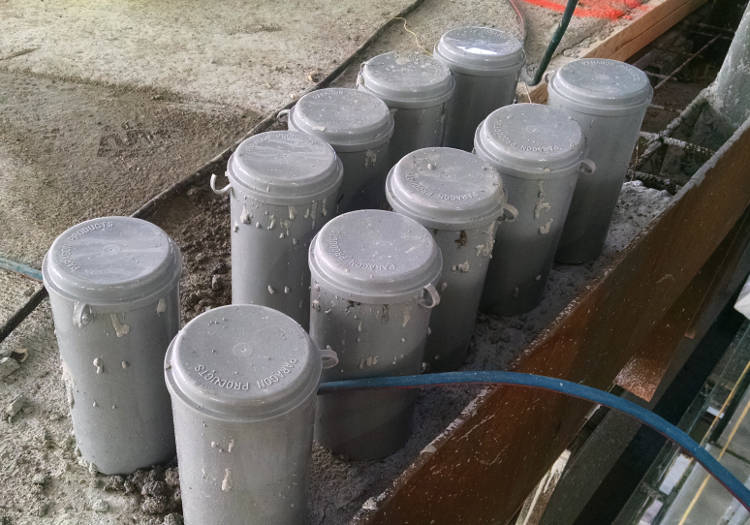Testing of concrete is vital to ensuring the strength and resilience of built structures. Testing of concrete materials can be divided into two primary categories: field testing and laboratory testing.
Field Testing of Concrete
Field testing of concrete can occur during concrete installation or during investigative evaluations of installed concrete to determine strength qualities.

Concrete Slump Tests
Concrete slump testing is used to evaluate the flow characteristics of freshly mixed concrete. To conduct a slump test, concrete is placed into an inverted cone in three stages, using a metal rod to tamp down the concrete after every stage. Once the cone is full, it is lifted off the working surface using handles on both sides of the cone, at which point the concrete subsides or “slumps” towards the ground due to gravity. The distance between the original height and slumped height is measured, and this is recorded as the slump.
Typically, slumps in the range of 4 to 5 inches are considered an ideal balance between workability and consistency. Anything less than this range is hard to work, while anything greater tends to segregate during placement. This video shows a slump test demonstration.
Air Content Testing
Air is entrained within concrete to provide for expansion and contraction capability, particularly in areas that experience significant swings in outside temperature, such as the northern US and Canada. Field air content testing of concrete is conducted to determine if delivered concrete is within the air content specifications established by the engineer.
To conduct an air content test, the field technician fills a circular metal base with three lifts of concrete, which are tamped using a metal rod similar to the technique used for concrete slump testing. Once the base is full of concrete, a metal lid with a pressure gauge attached is placed on top and the two parts are locked together. A hand pump is used to pressurize the device to a calibration point and then it is allowed to stabilize. After stabilization, the pressure is released, and the technician can read the concrete air content from a dial attached to the device.
Unit Weight
Unit weight determination of concrete is relatively easy. Fresh concrete is placed inside a container of known volume and weighed to provide the unit weight or density of the concrete. This is typically reported in pounds per cubic foot in the United States.
Field Testing of Existing Concrete
Forensic investigations and retrofits of existing structures sometimes require knowledge of the strength of existing concrete. There are two primary means of establishing the strength: nondestructive and destructive.
Schmidt Rebound Hammer
The primary means of nondestructive testing concrete is through the use of a Schmidt Rebound Hammer. The hammer works through firing a spring-loaded mass at the concrete and measuring the value of the rebound of the mass off the concrete. This value can be compared against a conversion chart to provide a rough estimate of the compressive strength of the concrete. Typically, the hammer must be calibrated before use and the test applied to several points in the testing area to establish an average value.
Destructive Concrete Testing
To obtain a much more accurate value of the concrete compressive strength, destructive testing can be used. In this method the existing concrete is cored, and a cylinder removed, which is then delivered to a laboratory for testing using the same method to that applied to cylinders from recently poured concrete. We cover laboratory compressive tests below.
Lab Testing of Concrete
Tests for compressive strength and flexural strength are best done through destructive testing in a laboratory.
Compressive Strength Lab Test
In order to determine if the concrete that was delivered and placed at a construction site is meeting the strength requirements as established by the engineer, laboratory testing is conducted on representative cylinders of concrete from that project. The cylinders are created in the field during concrete placement and are chosen at random points during the concrete pouring process. To create the cylinders, concrete is placed in plastic molds in three lifts, which are compacted with a metal rod during the placement of each lift. Cylinders are typically allowed to cure in the field for a few days before being picked up and delivered to a concrete testing laboratory. An image of some concrete cylinders on a job site is shown below.

The laboratory will test the concrete cylinders at 7, 14, 28, and occasionally 56 days after field installation to determine compressive strength at those curing intervals. This is accomplished using a device that applies force to the ends of the concrete cylinder until it breaks under the load. The value of the force at breakage is divided by the cross-sectional area of the cylinder to provide a strength in pounds per square inch. The following video shows the compressive test for a concrete cylinder.
Tensile or Flexural Testing of Concrete
In addition to a compressive strength test, concrete installed in aircraft runway and highway applications often undergoes a flexural strength or a tensile strength test. The testing specimens are created in the shape of a rectangular beam, which when cured is subject to a load on both ends until it snaps in the center, providing engineers with a measure of the concrete’s ability to withstand bending forces.


